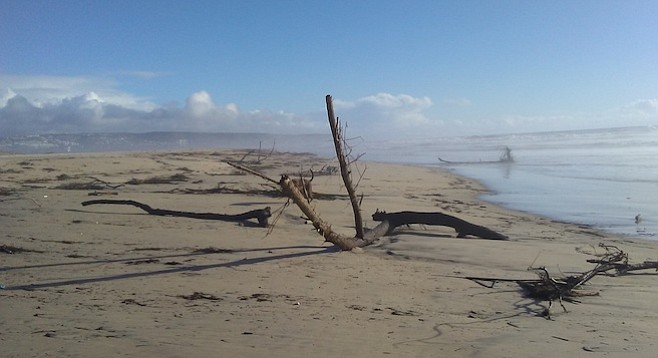 Facebook
Facebook
 X
X
 Instagram
Instagram
 TikTok
TikTok
 Youtube
Youtube

The beach north of the Tijuana River was littered with broken trees this weekend (February 18–19), a result of an enormous flow of rainwater and sewage from Tijuana hitting some of the 140,000 trees killed by the shot hole borer beetle.
The heavy rains also ended the stench of raw sewage apparently released last week by Tijuana’s municipal system that ended up far into the Tijuana River Valley before the fierce Friday rain.
On Friday (February 17), the river flow increased from less than 2 cubic meters per second to a high of 300 cubic meters per second, according to the International Boundary and Water Commission's data. By 7 a.m. Saturday, the gauge was measuring less than 20 cubic meters per second. But for about 18 hours, the river raged through the valley.
The mash-up of unwelcome forces created an eerily beautiful landscape north of the Tijuana River mouth, while forces from Friday’s storm carved the river mouth a wide opening. South of the river mouth, the beach appeared clear of tree debris. Trees washed up as far north as Dunes Park, where Imperial Beach lifeguards pulled them ashore and cut them up.
Steve Smullen, who manages the binational commission, said he got a call midweek from the U.S. Border Patrol Imperial Beach Station letting him know there was a strong raw-sewage odor near the station, immediately east of the Navy’s Outlying Field. Smullen found the odors north of the river near Saturn Street and at Hollister and then went to the area near the border at the end of the concrete channel that crosses the border.
“It was worse there,” Smullen said. He found it odd that he hadn’t heard about what was clearly a large sewage dump from water officials in Tijuana with whom the international commission works frequently. “It was weird because even when there is a spill, it’s usually diluted and this was not.”
The rush of water Friday picked up dead and broken trees as it rushed from the Dairy Mart bridge to Hollister Street bridge — so many in that mile and a half that they caused a logjam at the Hollister Street bridge, according to Mary Johnson, a member of the Tijuana River Valley Equestrian Association.
“The City of San Diego stormwater people have been great,” said Johnson. “They made a huge effort and set up a crane by the bridge to lift the jammed-up logs out from the bridge so it wouldn’t be undermined.”
The city’s efforts to clear the drainage channels appear to have paid off — last time the river valley had storms of this intensity, there was flooding that forced the evacuation of horses and left roads in low-lying areas impassable for days. This time, the roads were clear and drivable hours after the rain stopped, Johnson said.


The beach north of the Tijuana River was littered with broken trees this weekend (February 18–19), a result of an enormous flow of rainwater and sewage from Tijuana hitting some of the 140,000 trees killed by the shot hole borer beetle.
The heavy rains also ended the stench of raw sewage apparently released last week by Tijuana’s municipal system that ended up far into the Tijuana River Valley before the fierce Friday rain.
On Friday (February 17), the river flow increased from less than 2 cubic meters per second to a high of 300 cubic meters per second, according to the International Boundary and Water Commission's data. By 7 a.m. Saturday, the gauge was measuring less than 20 cubic meters per second. But for about 18 hours, the river raged through the valley.
The mash-up of unwelcome forces created an eerily beautiful landscape north of the Tijuana River mouth, while forces from Friday’s storm carved the river mouth a wide opening. South of the river mouth, the beach appeared clear of tree debris. Trees washed up as far north as Dunes Park, where Imperial Beach lifeguards pulled them ashore and cut them up.
Steve Smullen, who manages the binational commission, said he got a call midweek from the U.S. Border Patrol Imperial Beach Station letting him know there was a strong raw-sewage odor near the station, immediately east of the Navy’s Outlying Field. Smullen found the odors north of the river near Saturn Street and at Hollister and then went to the area near the border at the end of the concrete channel that crosses the border.
“It was worse there,” Smullen said. He found it odd that he hadn’t heard about what was clearly a large sewage dump from water officials in Tijuana with whom the international commission works frequently. “It was weird because even when there is a spill, it’s usually diluted and this was not.”
The rush of water Friday picked up dead and broken trees as it rushed from the Dairy Mart bridge to Hollister Street bridge — so many in that mile and a half that they caused a logjam at the Hollister Street bridge, according to Mary Johnson, a member of the Tijuana River Valley Equestrian Association.
“The City of San Diego stormwater people have been great,” said Johnson. “They made a huge effort and set up a crane by the bridge to lift the jammed-up logs out from the bridge so it wouldn’t be undermined.”
The city’s efforts to clear the drainage channels appear to have paid off — last time the river valley had storms of this intensity, there was flooding that forced the evacuation of horses and left roads in low-lying areas impassable for days. This time, the roads were clear and drivable hours after the rain stopped, Johnson said.
Comments